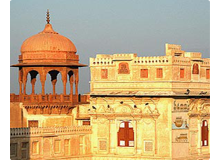Bikaner
 Bikaner is a city in the northwest of the state of Rajasthan in northern India. The name of Bikaner was derived from the two names Bika and Nehra. It is located 330 kilometres (205 mi) northwest of the state capital, Jaipur. Bikaner city is the administrative headquarters of Bikaner District and Bikaner division. It was formerly the capital of the princely state of Bikaner. The city was founded by Rao Bika with the help of Nehra Jats. Bikaner. in 1486 and from its small origins it has developed into the fifth largest city in Rajasthan. The Ganges Canal, completed in 1928, and the Indira Gandhi Canal, completed in 1987, facilitated its development.
Bikaner is a city in the northwest of the state of Rajasthan in northern India. The name of Bikaner was derived from the two names Bika and Nehra. It is located 330 kilometres (205 mi) northwest of the state capital, Jaipur. Bikaner city is the administrative headquarters of Bikaner District and Bikaner division. It was formerly the capital of the princely state of Bikaner. The city was founded by Rao Bika with the help of Nehra Jats. Bikaner. in 1486 and from its small origins it has developed into the fifth largest city in Rajasthan. The Ganges Canal, completed in 1928, and the Indira Gandhi Canal, completed in 1987, facilitated its development.
Junagarh Fort :
The fort was built by Raja Rai Singh, the sixth ruler of Bikaner who reigned from 1571 to 1612. Rai Singh had conquered part of Marwar and had been granted territory in Gujurat and Burhanpur by the Mughal emperor Akbar as a reward for his services as military commander. This, as well as funding from Jodhpur, enabled him to build the fort. Rai Singh held high rank in the imperial courts of both Akbar and his successor, Jehangir. During his imperial service he travelled extensively, giving him an appreciation of art and architecture. These ideas have been incorporated meticulously into the architectural style of Junagarh Fort.
Laxmi Niwas Palace :
The Laxmi Niwas Palace is a former residential palace of the king of the former Bikaner state, Maharajah Ganga Singh in Bikaner in the Indian state of Rajasthan. It was designed by the British architect, Samuel Swinton Jacob in the year 1902. The style of architecture is Indo-Saracenic. It is now a luxury hotel owned by Golden Triangle Fort & Palace P. Ltd. The magnificent structure in red sandstone is one of the most popular destinations for tourists in Bikaner.
Lalgarh Palace :
Lalgarh Palace was built between 1902 and 1926 according to Rajput, Mughal and European architectural styles. The building was commissioned by Maharaja Ganga Singh (1889-1925) in memory of his father Maharaja Lall Singh and was designed by the British architect, Samuel Swinton Jacob. It is coated in red sandstone and has several grand halls, lounges, cupolas and pavilions. The building features magnificent pillars, elaborate fireplaces, Italian colonnades and intricate latticework and filigree work. The palace houses the Shri Sadul Museum as well as a large and important collection of Sanskrit manuscripts, the Anup Sanskrit Library. Though the Bikaner Royal Family still live in the palace, part of the building has been converted into a Heritage hotel operated by the Royal family of Bikaner.











 Manali
Manali

